Tuxtepec, Oaxaca 作者: 来源: 发布时间:2021-11-17
1.Population and Area
Pop: 94,209 (city)
Area: 933.9 km2 (munip.)
Elev: 20 masl
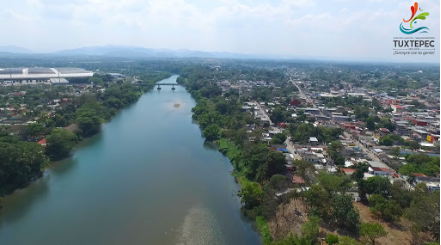
https://goo.gl/maps/uCteYSmiSdcU8JbH9
2. Natural geography
Orography
It has a slightly mountainous orography, since it is the coastal plain of the Gulf of Mexico and the Sotavento plains to the north and the Chinantec mountain range and the Sierra de Juárez to the south.
Hydrography
The municipality has a large amount of water resources, being in one of the most important hydrological basins in the country, that of the Papaloapan River. This river is supplied by others such as the Tonto river, the Valle Nacional river and the Santo Domingo river. Thanks to the capacity of this, Tuxtepec and the entire region have numerous springs and water sources, all from the Sierra Madre del Sur and the Sierra de Juárez.
In its territory, there are the Miguel Alemán and Miguel de la Madrid dams, which provide the development of fish farming and provide electrical energy that supplies the states of Veracruz, Oaxaca and Puebla.
Flora and fauna
The vegetation formed by different types of species such as amate, fig, guapinol, avocado, oak, cedar, lináloe, palm, ceiba, hormiguillo and grasslands.
They inhabit wild species such as the porcupine, armadillo, raccoon, deer, temazate, white-tailed deer, gray fox, hawk and hawk.
Köppen Classification: Tropical Monsoon Climate
Tropical monsoon climate, occasionally also known as a tropical wet climate or tropical monsoon and trade-wind littoral climate in climate classification, is a relatively rare type of climate. Tropical monsoon climates have monthly mean temperatures above 18°C (64°F) in every month of the year and feature wet and dry seasons, as Tropical savanna climates do. Unlike tropical savanna climates however, a tropical monsoon climate's driest month sees less than 60 mm (2.36 in) of precipitation. Also a tropical monsoon climate tends to see less variance in temperatures during the course of the year than a tropical savanna climate. This climate has a driest month which nearly always occurs at or soon after the "winter" solstice for that side of the equator.
The Köppen Climate Classification subtype for this climate is "Am". (Tropical Monsoon Climate).
The average temperature for the year in San Juan Bautista Tuxtepec is 78.4°F (25.8°C). The warmest month, on average, is May with an average temperature of 84.2°F (29°C). The coolest month on average is January, with an average temperature of 71.1°F (21.7°C).
The highest recorded temperature in San Juan Bautista Tuxtepec is 111.2°F (44°C), which was recorded in April. The lowest recorded temperature in San Juan Bautista Tuxtepec is 50.0°F (10°C), which was recorded in December.
The average amount of precipitation for the year in San Juan Bautista Tuxtepec is 81.8" (2077.7 mm). The month with the most precipitation on average is July with 17.1" (434.3 mm) of precipitation. The month with the least precipitation on average is March with an average of 1.2" (30.5 mm). In terms of liquid precipitation, there are an average of 128.1 days of rain, with the most rain occurring in July with 20.1 days of rain, and the least rain occurring in April with 4.3 days of rain.
http://www.weatherbase.com/weather/weather-summary.php3?s=920294&cityname=San+Juan+Bautista+Tuxtepec%2C+Oaxaca%2C+Mexico&units=metric
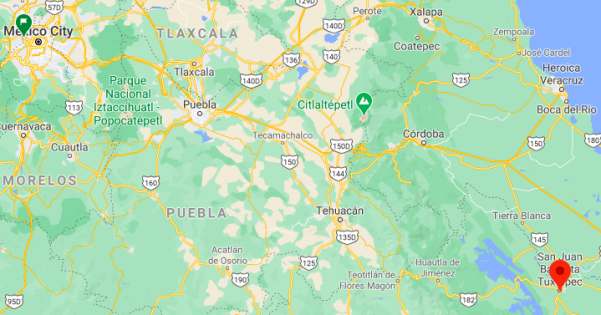
Getting there and around
Get there
By air –You can fly to the Oaxaca airport and take a bus or drive from there to Tuxtepec. The quickest flight from Mexico City Airport to Oaxaca Airport is the direct flight which takes 1h 5m.
By car – The quickest way to get from Mexico City to Tuxtepec is to drive which costs $750 - $1200 and takes 6h 30m, via Mexico 150D highway. The distance between Mexico City and Tuxtepec is 349 km. The road distance is 431.3 km.
By bus – The cheapest way to get from Mexico City to Tuxtepec is to bus which costs $550 - $1000 and takes 9h 7m. There are services departing from México TAPO and arriving at San Juan Bautista Tuxtepec via Puebla. The journey, including transfers, takes approximately 9h 7m.
https://www.rome2rio.com/s/Mexico-City/Tuxtepec
Car Rental – To explore Mexico’s provincial towns and cities—including its beach locations and the scenery and attractions near them— consider renting a car for your visit. Having your own car will give you more flexibility than using public transport options and, in some cases, offer you access to places which are otherwise difficult to visit without the use of a car.
COVID19 – International entry into Mexico from United States
Allowed for: All visitors arriving by air. Mexico land borders are closed to non-essential travel
Restricted for: There are no current restrictions.
Get around
Local Buses – Local buses and mini-buses (combis or micros) are available locally for a fraction of the cost of a taxi around town. You need to speak Spanish to be able to ask for directions or ask the driver to tell you where to get off.
Taxis – Taxis in most of Mexico’s towns and cities are not metered, so agree your price before you get in. Taxi travel is very affordable in Mexico, in comparison to the USA, Canada and Europe, and so provides a viable means of public transportation in Mexico. Your hotel can arrange taxis for you; some post their rates on a board in the lobby; taxi hotel rates are usually higher than cabs you hail off the street. If you speak Spanish, you will have a distinct advantage and be able to negotiate a price with the driver.
Uber is expanding rapidly across Mexico and now offers services in cities across the country, including: Mexico City, Toluca, Cuernavaca, Puebla, Querétaro, León, Aguascalientes, San Luis Potosí, Guadalajara, Monterrey, Hermosillo, Tijuana, Mexicali, and Mérida. Uber has been adding Mexican cities to its network every year, check for availability when you arrive at your destination in Mexico.
Cabify and Didi are also developing and currently operate in cities including Mexico City, Toluca, Monterrey, Puebla, Querétaro and Tijuana. Check for availability in the city you are visiting.
These services offer people with smartphones a way to book a cab through a mobile app for a pre-agreed price. Fares are comparable with Sitio type cabs, and sometimes trade at a premium to this when local demand increases.
https://www.mexperience.com/transport/taxi-travel-in-mexico/#51
3. ECONOMY
GDP: 14,686 M MXN (2010)
https://imco.org.mx/ciudades2010/ciudades/72_Tuxtepec.html
4. Industry characteristics
Farming
Due to its privileged nature, similar to that of the state of Veracruz, with exuberant vegetation, abundant water and a warm humid climate, Tuxtepec has a high production of sugar cane and fruit products, such as banana, mango, pineapple, avocado, taro , various kinds of citrus, rubber plants; in addition to grains such as rice and coffee. The production of green chili, beans and corn also stands out.
The evolution of agriculture in Tuxtepec was marked by the periods of traditional crops, the ranch exploitation and the time of green gold (roatan and macho banana) and the local agricultural response that promoted the improvement of crops, mainly sugar cane. and banana. At present, lychee sowing has been widely promoted.
Cattle raising
Livestock is another of the important activities of the municipality, due to the large amount of natural pastures that allow grazing and raising livestock in a simple and efficient way. Tuxtepec cattle ranching increased in the 1940s and became a basic component of the town from the 19th century. The production of bovine cattle and the raising of poultry stand out.
Fishing
Fish farming is one of the most deeply rooted activities in the municipality; In the early days of the city, it maintained constant growth and was considered one of the main activities of the region, during the period that Mr. Jorge L Tamayo was the executive member of the Papaloapan Commission from 1973 to 1984, they were brought from Japan the baby mojarras and deposited in the reservoir of the Miguel Alemán dam (Temascal) for their reproduction, species of mojarra whose meat is fine and appreciated. Fishing activity was diminished by river pollution and asolve, and by the diversification of other activities that led to this, such as industry. Due to the high pollution of the Papaloapan River, the species that inhabit it are inedible. In fact, fishing is practiced in the reservoirs of the Miguel Alemán and Miguel de la Madrid dams. The species tilapia, tenhuayaca and criolla or colorada are caught. Likewise, the creation of mojarra tilapia ponds in the communities has been increasingly promoted, which has served as an important source of income for the rural economy of the municipality. This activity also takes place in the few clean natural tributaries that the municipality and the region have, increasingly threatened by contamination from pesticide residues used in agriculture.
Commerce
Tuxtepec's trade is the most important and fastest growing activity. The city of Tuxtepec is the most important commercial pole in the Papaloapan Basin Region. Such is the importance for commerce in Tuxtepec that 80% of the population is dedicated to commercial activity.
Tuxtepec maintains more frequent commercial relations with the states of Veracruz, Puebla and Mexico City and less frequent with the cities of Oaxaca de Juárez, Guadalajara and Monterrey.
It has become the main meeting point for the buying / selling activities of the surrounding places. Commerce is made up of most forms of this, with distribution centers for electrical appliances, department stores, large supermarkets (both national and foreign) and various distribution companies of all kinds, both national and foreign.
Being in this way that there are 4 municipal markets, 3 tianguis and a large number of commercial establishments of all kinds. Due to their commercial activity, the Avenues stand out in the City: Independencia, November 20, May 5 and Libertad, which work all day.
Tourism
Within the municipal area, the development of this economic activity has not been fully exploited, despite the many existing natural beauties. Tourism has been limited to visits to industries and shopping centers.
Among the promotional activities are the May Festivities, where the City Fair takes place, where year after year artists of national and international fame participate; being a show also for the dissemination of their productions, as are the livestock and beer exhibition.
In the city, promotional events are held for the dissemination of the same region, such as meetings of versadores, soneros, poets and decimistas tuxtepecanos. In addition to its Nauticopa that has been held since 1970 on the Tonto River, the recent administration, seeing that the Papaloapan River is practically in extinction, moved the event to the Miguel de la Madrid Dam, thus taking the 2004 and 2007 editions, that had a visit of 8 to 10,000 people per day.
The Bethania Waterfalls are crystal clear waterfalls located in the town of Bethania 24 km from the city, on the Tuxtepec-Palomares highway. The Muro Boulevard with its green areas on the banks of the river is very beautiful.
The main tourist route it has is the aforementioned Muro Boulevard, which with its 5 km borders the northern part of the city and gives a panoramic view of the Papaloapan River. In it there are numerous restaurants, nightclubs, shops, as well as the El Flamenco Recreation Center, which with municipal development, is one of the main recreational centers of the municipality designed for children. There are also numerous constructions that are preserved despite the flood of '44 and the industrialization suffered by Tuxtepec.
The infrastructure of its hotels gives the municipality the capacity of 990 rooms, ranging from inns to 4-star hotels; to satisfy not only the incipient tourism, but also the demand for this service by industry and commerce.
In addition, there are numerous other streams that are invaded by tourists (mainly local) and, recently, national in the hot months of April and May. Streams like the "naranjal", located in the town of San Isidro naranjal is located in the Municipality of San José Chiltepec (in the state of Oaxaca) and also known as the eye of the water "el zuzul" located in the municipality of Santa María Jacatepec from Oaxaca.
5. Attractions
Bethania Waterfalls
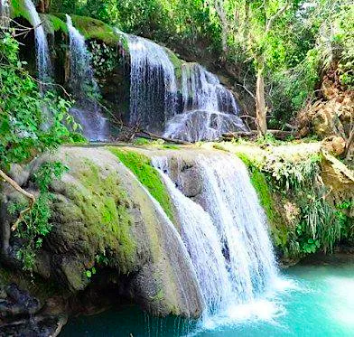
These multiple crystalline waterfalls offer a wonderful show and a great place to take a dip. At the river you will find a large expanse of green space ideal for a picnic, camping, long walks or just sit to enjoy nature. You also find several streams where you can refresh during the hottest months, which are usually April and May.
The waterfalls are formed in times of rain (spring-summer). Around, there are springs and green areas to rest.
Unlike other communities in Oaxaca or Mexico, in Bethania most of its inhabitants are evangelicals and the minority is Catholic. Bethania means “place of rest” or “house of God” and here, alcohol is prohibited.
When you visit Bethania, respect the rules of the community.
https://www.zonaturistica.com/en/things-to-do/oaxaca/tuxtepec/waterfalls-of-bethania
http://tuxtepecturismo.com/en/what-to-do/springs-waterfalls/bethania-waterfalls
Spider Monkey’s Habitat
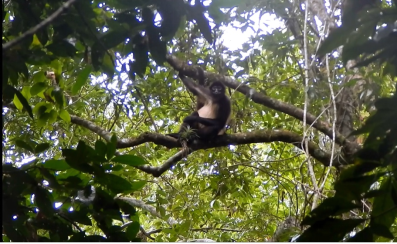
La Chinantla has the third largest jungle in Mexico. Here different types of animals live, including the jaguar and the spider monkey. The population of the latter has recovered thanks to conservation efforts.
A university from Barcelona (Universidad de Girona) and the Universidad Veracruzana recorded the documentary “Super Chango” to show the efforts of the Chinantla towns for the conservation of the spider monkey.
There are two Chinantec communities that have been in charge of the conservation and protection of the spider monkey in La Chinantla jungle. Community members have become experts in locating these animals and they offer their services to observe them in their natural habitat.
Villagers have stopped hunting animals and in coordination with the National Commission of Protected Natural Areas (CONANP) they have dedicated themselves to conservation. Due to this effort, the population of spider monkey, wild boar, jaguars and other animals has increased.
The first community is Cerro Chango. It has an ecotouristic center that offers cabins for rent. In addition to visiting the spider monkey, you can take boat trips on the river, tours to caves, climb the lookout to see the natural beauty of the jungle and visit the community chapel built in a cave.
The second community is Soledad Vista Hermosa that is deeper in the jungle, therefore, the probability of observing the spider monkey is almost guaranteed. This community also organizes the spider monkey festival.
To get to these communities from Tuxtepec is recommended to take the 147 Palomares-Tuxtepec federal highway and pass the Tesechoacán river that divides Oaxaca and Veracruz. Take the diversion towards Río Manso. Before arriving to the community of Río Manso you will see signs indicating that to the right is Cerro Chango.
If you want to get to Soledad Vista Hermosa, you must reach the community of Río Manso and take the deviation to the right to cross the Tesechoacán River again. Continue straight for about 4 km and you will reach your destination.
http://tuxtepecturismo.com/en/what-to-do/nature-ecotourism/spider-monkey-habitat
Mil Islas
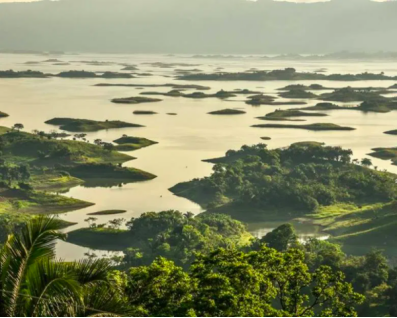
A Thousand Islands was formed when thousand of hectares of fertile land were flooded in the 50’s for the construction of the Miguel Alemán Dam. The Chinantla is an area with many hills and the water could not cover them all. This gave rise to A Thousand Islands.
Many of the islands are uninhabited and do not have owners. Others are whole communities, ranches or are used for livestock.
The best places to admire the Islands are in the town of San Andrés Cerro Quemado or at the top of Isla Soyaltepec.
In Cerro Quemado there are three viewpoints to have a panoramic view of the Thousand Islands. This town has the eco-touristic center Mil Islas that offers lodging services, boat or canoe, hiking and more.
Another point from where you can admire the Thousand Islands is from Isla Soyaltepec. In addition to the spectacular view, you can also do other activities. You can visit the Church of San Miguel de Arcángel that is almost 500 years old. You can also hike through the Island with the help of a local guide.
If you visit San Pedro Ixcatlán you will have the opportunity to rent boats to visit one of the Thousand Islands, including the ranch “La Chingada”.
http://tuxtepecturismo.com/en/what-to-do/nature-ecotourism/a-thousand-islands-mil-islas
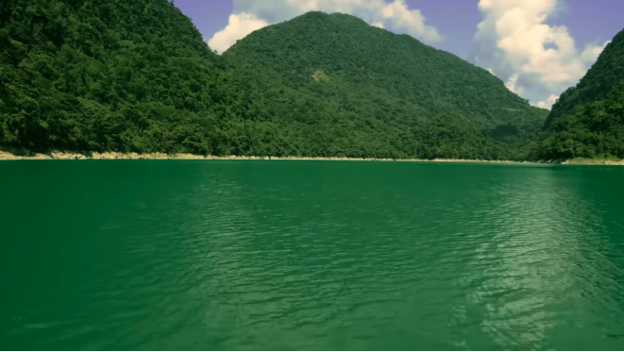
OAXACA. MIL ISLAS #OaxacaDesdeEl Aire
https://youtu.be/ON5PXufpepo
6. History
This municipality was founded in the year 1811 and decreed as a municipality by the Local Chamber of Commerce on March 15, 1825. The 1858 law established Tuxtepec as a district political headquarters and was made up of 3 towns and 16 towns. The synoptic and statistical table of the time (1880) indicates that the population of the municipality did not reach 2,300 inhabitants and that the majority were women. He also says that the population was of three classes: mulatto, indigenous and Spanish. The dance of the time was on stage and was called Guapango. It had three public buildings: church, municipal house and theater. The main trade was in the bouquets of lingerie, groceries, hardware, haberdashery, earthenware and liquors and it produced cattle, cane, tobacco, coffee, cocoa, rubber and cotton. The pineapple was not yet known. The ranches were the following: Mixtán, Paso canoa, Arrollo de pita, Playa de mono San Antonio, El Encinal, El Rosario, San Isidro, Mundo nuevo, El hule, Rio viejo, Santa Teresa, Tontepec, Palmilla, Yagual, Cuapa, Buenavista, Cacahuatepec, La Candelaria and Montiel. In them the dairy work typical of the Jarocha culture was exercised. The languages among the indigenous people were Mazatec and Chinantec. Mulattoes and Spaniards spoke Spanish in its Andalusian variety. In the municipal agency of Amapa Santa María there lived 309 black inhabitants descendants of the Maroons who fled from Yanga and San Juan de la Punta.
Prehispanic era
The population dates from the pre-Hispanic period. There is no historical evidence that the Chinantecs and Mazatecs were original settlers. There are data that the first settlers were Olmecs, later Popolucas and by 1450 3,000 Tenochcas and Tlatelolcas arrived from what is now Mexico City, who implanted the Nahuatl language for the next three centuries.This territory was annexed to the Aztec Empire, at that time directed by Moctezuma I, in the year 1463 for being an important commercial point for the southern routes of the Empire.
Discovery
On March 6, 2012, it was announced that vestiges of an Aztec city were discovered in the Mundo Nuevo colony, with an area of 20 hectares and a population of approximately 20,000 inhabitants. The excavation works are expected to take around 5 years.
Colonial Time
By 1520, it was part of the newly founded Viceroyalty of New Spain, becoming the headquarters of a military garrison that led to the Villa de Antequera, now Oaxaca.
Independence and Reform
In 1810 it appeared as the municipal seat of the jurisdiction of Tehutila. In 1844, according to the Law of May 11, it was judicial head of the region and on March 19, 1858 it became a district.
On January 10, 1876, in the town of San Lucas Ojitlán, belonging to the District of Tuxtepec, the Plan of Tuxtepec was promulgated, in which General Porfirio Díaz did not recognize Sebastián Lerdo de Tejada as president of the nation, due to his re-election. In this, Díaz was fighting for the non-reelection of the president of the republic.
Porfiriato
In the Villa de Ojitlán municipality of San Lucas de Ojitlán, Tuxtepec was proclaimed the Plan of Tuxtepec on January 10, 1876 by Porfirio Diaz with the purpose of overthrowing Sebastián Lerdo de Tejada. The manifesto was also signed by General Hermenegildo Sarmiento, who was the head of the local garrison and was reformed by the Plan of Palo Blanco Tamaulipas, which recognized Gral. Porfirio Díaz as president.
Porfirio Díaz managed to defeat the forces of Lerdo de Tejada in Tecoac (Puebla), on November 16, 1876, with which he acceded to the government of Mexico a week later.
Revolution
At the time of the Revolution, around 1910, the Villa de Tuxtepec was a town of large, white houses, with a tile coffered ceiling and large windows and doors to withstand the heat of the abundant jungle in the area. Tuxtepec had a population of 5,500 inhabitants that grew along the now main Avenida Independencia and the well-known Paso Real, where the steam barges of the Navigation Company of the Rivers of the Sotavento Coast arrived, which transported merchandise. from Alvarado, Veracruz, navigating the Papaloapan River.
The Revolution in the Papaloapan Basin was fought by General Jesús Carranza Garza.
On May 5, 1928, Tuxtepec rose to the category of city, being municipal president, Carlos Cruz Montiel, originally from the town of Tlacojalpan, Veracruz and who during the period from 1926 to 1928 was part of the Legislature of the State of Oaxaca as substitute local deputy. He was also poisoned during a working lunch while running for governor of the state of Oaxaca.
1944 flood
In 1944, Tuxtepec experienced one of the many natural catastrophes in its history, known in the press as the Tragedy of Tuxtepec.
The flooding of this place is still remembered by residents for its tragedy and heartbreaking aspect, having its date on September 27. The newspaper El Universal dedicated an alarming headline "Tuxtepec has practically disappeared."
The inhabitants of Tuxtepec ask for help because they don't have to eat.
The main houses of the city were washed away by the current of the river, as well as the commercial buildings, losing all the merchandise.
The streets are impassable and the houses that still stand are littered with rubble and the streets of holes. Inside what were rooms there are tons of sand in which, without a doubt, many corpses are buried.
The Papaloapan overflowed its channels through a stationary front on the coasts of Oaxaca, Guerrero and Chiapas, causing gusts of 15 m / s; which caused the river waters to reach levels of 4 to 9 meters above the surface of the city. The river levels lasted for 3 days, as the water level dropped, it revealed numerous corpses of animals and people, remains of roofs and buildings.
When the city prison was flooded, the prisoners were able to escape from it, which is why on this day the Prisoner's Day is commemorated, giving freedom to some of the inmates that the city claims.
The flood affected about 500,000 hectares and caused damages of 30 million Mexican pesos. At the time it was declared the worst catastrophe of the century, however, the 1969 flood was the one with the greatest economic losses, only surpassed by the 1985 Earthquake.
During this tragedy, the state of Veracruz was the one that immediately prepared the necessary aid and humanitarian aid.
While President Manuel Ávila Camacho toured the entire affected area accompanied by the Governor of Oaxaca Vicente González Fernández, the Governor of Veracruz Jorge Cerdán Lara, as well as the Secretary of the Interior Miguel Alemán Valdés. The inhabitants of the area gave applause, cheers and ovations to the Veracruz governor in gratitude for the immediate help he provided, unlike his Oaxacan counterpart, who was totally ignored.
Due to the frequent floods caused by the Papaloapan, and the 1944 flood being the last incentive, the federal government issued a Presidential Agreement that declared the study and construction of the control works of the Papaloapan River of public utility.
Present
Tuxtepec recorded faster growth in the 1980s, due to the arrival of Compañía Cervecera del Trópico S.A de C.V., with which the demand for jobs increased, causing the creation of new educational centers, such as the Technological Institute of Tuxtepec.
Previously, the Oaxacan Governor was represented by caciques, who exercised control of the Region, Francisco Moreno serving in this position for many years.
Lic. Pérez Gasga, Oaxacan governor, had an interest in the region and began to frequent the Papaloapan Basin. The Tuxtepec-Oaxaca highway was built on dirt. The paper factory was established, the purpose of which would be to take advantage of the wood from the Sierra de Juárez.
Given its geographical location, Tuxtepec tends to identify itself more with the state of Veracruz than with that of Oaxaca. Before 1958, the region was represented on the Mondays of the Hill by the "Fandango Jarocho". It was then that Governor Alfonso Pérez Gasga decided to replace this with a new dance, with more Oaxacan features, creating the dance "Flor de Piña", which would be the one that would finally represent the entire region, since the previous one seemed be more from Veracruz than from Oaxaca (although in reality he was from Cuenca).
During the six-year term of Lic. Rodolfo Brena Torres, who most frequently visited the Tuxtepec area, the Silverio rice mill (now under renovation), the Adolfo López Mateos Sugar Mill and some pineapple packing plants were established in the city of Loma Bonita.
Already with the governor Dr. Victor Bravo Ahuja, in Tuxtepec there was a complete change, thanks to the fact that the state government began to take more into account the Papaloapan Region, with a tuxtepecan in the governorship and later Secretary of Public Education, promoted the education sector by creating higher-level schools, introduction of mercury light, introduction and expansion of electrical energy to various communities in the region, paving streets, paving the Tuxtepec to Oaxaca highway, construction of the Tuxtepec to Palomares highway, the house of culture (which bears his name in honor), expansion of the drinking water network both in the city and throughout the region.
At that time, for other Oaxaqueans visiting Tuxtepec was a novelty. Today, the city is already more integrated with the state capital. It is worth mentioning that people go to the Oaxacan capital for political and work matters, the most frequent business and pleasure trips are made with Veracruz, Puebla and Mexico City.
With the Internet and the fax, it is already more closely linked to Oaxaca, but due to its proximity, proximity and geographical point with the State of Veracruz, the customs and idiosyncrasy of Tuxtepecan are still 90% Jarocha. Every time a Tuxtepecan visits the port of Veracruz or some other neighboring city, he identifies himself more than when he visits the Oaxacan capital, noting the change and difference of the Tuxtepecans towards Oaxaca, for their customs, traditions, words, tone of voice and gastronomy , very different from that of Cuenca; The same thing happens to them too, when they visit the region.
7. Other Information: Plan of Tuxtepec
The Plan of Tuxtepec was a plan drafted by General Porfirio Díaz in 1876 and proclaimed on 10 January 1876 in the Villa de Ojitlán municipality of San Lucas Ojitlán, Tuxtepec district, Oaxaca. It was signed by a group of military officers led by Colonel Hermenegildo Sarmiento and drafted by porfiristas Vicente Riva Palacio, Irineo Paz, and Protasio Tagle on the instigation of Díaz. Díaz signed the previous version of the plan in December 1875, which did not include the three most important articles that appointed Diaz as president. It disavowed Sebastián Lerdo de Tejada as President, while acknowledging the Constitution and the Reform laws, and proclaimed Díaz as the leader of the movement. Díaz later became the president of Mexico.
Upon the death of President Benito Juárez in 1872, Sebastián Lerdo de Tejada, the President of the Supreme Court, assumed the interim presidency, and called for new elections. The two candidates registered were Lerdo de Tejada and General Porfirio Díaz, one of the heroes of the Battle of Puebla of 5 May 1862, who had since occupied several public positions. Díaz had challenged Juárez with his Plan de la Noria, in which he stated his opposition to presidential re-election and called for a Constituent Congress. Lack of support for this plan led to Díaz losing the elections of 1872.
Towards the end of his term, Lerdo de Tejada, who had already incorporated the Reform laws into the Constitution of Mexico, attempted to modify the constitution to enable his re-election, prompting Díaz to declare the Plan of Tuxtepec. On 21 March 1876, Díaz rebelled against President Lerdo de Tejada. The Plan of Tuxtepec proclaimed the "No Re-election" principle and emerged as the flag of General Porfirio Díaz. The plan had the support of General Donato Guerra, the head of the Mexican army, as well as other military chiefs who helped the movement in Jalisco on February 8, 1876. In the municipalities of Lagos, Teocaltiche, Jalostotitlán and San Miguel El Alto, Generals Donato Guerra and Rosendo Márquez attacked the garrison of San Juan de los Lagos, which surrendered without a major fight. Other key figures were General Pedro Galván and Florentino Cuervo, who captured Ameca. Colonel Félix Vélez Galván took up arms in Sayula, Jalisco on 12 February.
Aftermath
On 20 May 1876 in Icamole, Nuevo León, General Carlos Fuero, loyal to the government of Lerdo de Tejada, inflicted a heavy defeat on Díaz's rebels, who were forced to withdraw to the south of the Republic. Despite this defeat, Díaz continued his campaign against the lerdistas.
On October 26, the Congress affirmed the re-election of Lerdo de Tejada, but the president of the Supreme Court of Justice, José María Iglesias, declared it illegal. In his role as vice-president, Iglesias pursued the interim presidency. By this failure Sebastián Lerdo de Tejada was forced to leave power.
On 16 November 1876, Díaz faced General Ignacio R. Alatorre in the Battle of Tecoac, in the municipality of Huamantla, Tlaxcala. Both sides came close to winning the battle, but the arrival of porfirista reinforcements under the command of General Manuel González Flores, caused a decisive victory for Díaz's troops. Following a series of further battles, supporters of the Plan of Tuxtepec claimed victory, and Lerdo de Tejada had no choice but to surrender the presidency and Díaz entered Puebla in November. As a result of the plan's victory Supreme Court President José María Iglesias was appointed interim president until new elections could be held in Mexico City. As the only candidate, General Porfirio Díaz assumed the presidency on 12 May 1877.
In 1878, supported by the Plan of Tuxtepec, Díaz made two key reforms to the Constitution. The first was to remove the function of vice-president from the president of the Supreme Court of Justice. The second prohibited re-election, with a short statement that said: "Except after a period of four years", with which he started his long dictatorship and the period of Porfiriato.
8. Contact Information

City Mayor: Noé Ramírez Chávez
Phone number: +52 (287) 875 2525
Facebook: https://www.facebook.com/soynoeramirezchavez
Twitter: https://twitter.com/SoyNoeRamirez
Website: http://tuxtepec.gob.mx
Govt. Office Address: H. Ayuntamiento de San Juan Bautista Tuxtepec, Av. 5 de Mayo S/N entre Allende Y Guerrero. Col. Centro. C.P. 68300 San Juan Bautista Tuxtepec, Oaxaca
